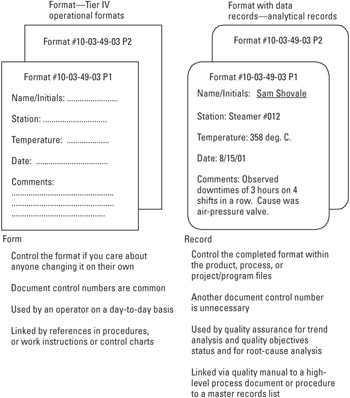Chapter 8: Forms and the Control of Records
|
8.1 Forms Versus Records
8.1.1 Formats
Forms/formats represent tier IV of the documentation pyramid. They are essentially templates within which data/information is deposited for analytical or informational purposes. When a form is filled in with data and signed and dated by the observer and filed away for a specific period, it is termed a record. The format is controlled by any number of methods. The most common control method is to assign a control number to the form. For example, a form used for internal audit reports might be labeled, F-8.2.2-002, with a revision level, Rev. 3. The form is maintained within the engineering change order (ECO) or document change order (DCO) system used to control higher tier documents.
It is also customary to include more complex formats, such as schematics and assembly prints, into tier IV, although such documents, when they are archived, are actually records because they are signed off and dated. Because the documents contain information and usually state specific work instructions, they could just as easily be classified as tier III documents. Consistency is more important than which tier is chosen for a specific document. The development of a master forms list is the most important element so that users can quickly find an appropriate form, and effective audits can be performed.
8.1.2 Analytical Linkage
Records are basically historical documents and are not part of the operational linkage. They are certainly part of the analytical linkage that forms an information context in parallel with the operational process. The Standard does realize this fine distinction in 4.2.3: Control of Documents and reminds us that records are to be controlled and that they form a unique category of documentation. However, invariably, records are shown as part of tier IV. I remain ambivalent on the subject, and my efforts in an audit are primarily spent to ensure that the records are clearly defined, in good shape, and under control.
The difference between operational and analytical linkage can be demonstrated if one considers that during the manufacturing cycle, the operator refers to a work instruction—a dynamic document. The operator does not refer to all of the process data sheets signed off over the past month to find out what to do in the next step.
However, the quality-assurance manager analyzes all of the process data sheets over the past month to look for trends in nonconformances and time-related issues.
The operator fills in the process data sheet form—a tier IV document—and the quality-assurance manager creates a nonconformance Pareto chart from the process data sheets. This becomes a record of nonconformance frequency versus months and years past.
It can get tricky. For example, a marketing and sales forecast of potential received orders (bookings) is a record that captures the marketing and sales estimate of anticipated bookings on a particular date. The record of this estimate establishes booking goals. This time-based set of goals becomes one of the data lines on the run chart of bookings obtained versus fiscal months. The next line on the run chart would be a record of actual bookings plotted in time. The combination of the two lines on the chart constitute a record of actual bookings versus anticipated bookings.
In contrast, a corrective action procedure is not a record. It is a dynamic document. However, the previous revision of the procedure is a record if it is kept because of legal or regulatory requirements (e.g., for the FDA). Sometimes, we find the current revisions of policies, processes, procedures, and work instructions included on a master records list. There is no harm in this activity as long as the auditee understands the difference between document and record control and has established the proper procedures to carry out such protocols.
This difference between forms and records is illustrated in Figure 8.1 and Table 8.1.
| Format—Tier IV Operational Formats | Format with Data Records—Analytical Documents |
|---|---|
| Form | Record |
| Control the format if you care about anyone changing it on their own | Control the completed format within the product, process, or project/program files |
| Document control numbers are common | Another document control number is unnecessary |
| Used by an operator on a day-to-day basis | Used by quality assurance for trend analysis and quality objectives status and for root cause analysis |
| Linked by references in procedures, work instructions, or control charts | Linked via quality manual to a high-level process document or procedure to a master records list |

Figure 8.1: Operational versus analytical linkage.
8.1.3 Bypasses for Forms
It is unnecessary to create documents so that every tier is covered—do what makes sense. In auditing, I live by the rule: If it sounds stupid, it's stupid. Sometimes I hear my clients murmuring to themselves, "sounds stupid—let's try something else," so it seems like a pretty good rule. Works every time. In other words, if it is required to go from the manual to a form (e.g., the format for management reviews), do it. It is not necessary to create an SOP and a work instruction to get to that form.
Figure 8.2 illustrates this concept. In the left-hand-side drawing, the forms are directly linked from both a procedure and a work instruction. In the middle drawing, the forms are directly linked from a work instruction. In the right-hand-side drawing, the forms are directly linked from the quality manual.

Figure 8.2: Possible ISO 9001—2000 forms linkage schemes.
|
EAN: 2147483647
Pages: 155